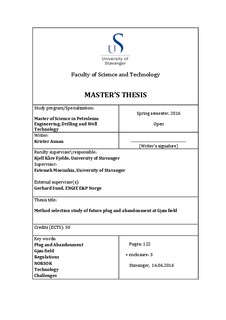| dc.contributor.author | Aunan, Krister | |
| dc.date.accessioned | 2016-09-19T12:18:25Z | |
| dc.date.available | 2016-09-19T12:18:25Z | |
| dc.date.issued | 2016-06 | |
| dc.identifier.uri | http://hdl.handle.net/11250/2408324 | |
| dc.description | Master's thesis in Petroleum engineering | nb_NO |
| dc.description.abstract | On the Norwegian Continental Shelf (NCS) there will be a wave of subsea and
platform wells that will eventually need to be plugged and abandoned (P&A’d) in
a safe and efficient manner. The well abandonment phase is the final stage
performed on the well, and it includes the establishment of permanent well
barriers to protect the environment.
All offshore hydrocarbon (HC) wells will, sooner or later, require permanent P&A
in order to control subsurface pressures and prevent the free flow of pore fluids
to the seafloor. There is a large diversity of well types to be P&A’d. Some less
complex wells can be plugged either by existing rig-less platform equipment, or
by a vessel technology. Other more complex wells will need a rig that can handle
more challenging and heavy P&A operations, including heavy retrieval of tubing
and casing, milling and cement repairs.
This thesis will discuss the process of permanently implementing P&A on the
subsea wells on the Gjøa field, given that sometime in the future these wells will
need to be P&A’d due to declining production. There are currently eleven
production wells at the field, and these wells can be categorized based on
differences in well design. This thesis also covers an overview of rules and
regulations governing P&A activities on the NCS. “P&A of offshore wells represents
a significant cost and liability to operating companies and national authorities,
while at the same time being governed by prescriptive downhole requirements.
Current requirements are prescriptive as to the number and size of permanent well
barriers required, and the requirements are the same for all types of wells” [1].
The main focus of this thesis is on technical solutions that are available today,
but it will also discuss the possibility of performing a final P&A job through the
use of more time and cost-effective solutions. P&A creates no added value for
operators and therefore the operation should be done as quickly and costeffectively
as possible. Today's conventional technology is in many ways
outdated, and to make P&A economically sustainable in the future there is a
great need for new technology and methods. | nb_NO |
| dc.language.iso | eng | nb_NO |
| dc.publisher | University of Stavanger, Norway | nb_NO |
| dc.relation.ispartofseries | Masteroppgave/UIS-TN-IPT/2016; | |
| dc.rights | Navngivelse 3.0 Norge | * |
| dc.rights.uri | http://creativecommons.org/licenses/by/3.0/no/ | * |
| dc.subject | petroleumsteknologi | nb_NO |
| dc.subject | petroleum engineering | nb_NO |
| dc.subject | Gjøa field | nb_NO |
| dc.subject | NORSOK | nb_NO |
| dc.subject | plug and abandonment | nb_NO |
| dc.subject | p&a | nb_NO |
| dc.subject | regulations | nb_NO |
| dc.subject | technology | nb_NO |
| dc.subject | offshore technology | nb_NO |
| dc.title | Method selection study of future plug and abandonment at Gjøa field | nb_NO |
| dc.type | Master thesis | nb_NO |
| dc.subject.nsi | VDP::Technology: 500::Rock and petroleum disciplines: 510::Petroleum engineering: 512 | nb_NO |

